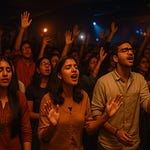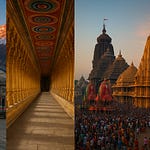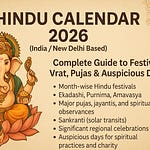Amidst the rugged grandeur of the Dhauladhar Himalayas, in the secluded valley of Bharmour (formerly Brahmpura), stands a temple that pulses with ancient energy — the Kartik Swami Temple. This shrine is one of the few North Indian temples dedicated to Lord Kartikeya, the warrior son of Shiva and Parvati, revered across India but mostly in the South.
Located within the sacred Chaurasi Temple Complex, this temple has been a beacon of faith for over 1,300 years, combining history, architecture, natural beauty, and deeply rooted mythological legacy.
🕉️ Origin & Mythological Foundations
📚 Puranic Context
Lord Kartikeya (Skanda, Murugan, Subrahmanya) was born from the six sparks of Shiva’s third eye, and was raised by the six Krittika stars. He symbolizes valor, youth, celibacy, and strategic wisdom.
He was created to destroy Tarakasura, a demon who could only be defeated by Shiva’s offspring. After his victory, Kartikeya is said to have retreated to the Himalayas for penance and solitude.
🏔️ Kartikeya in Bharmour
Local lore says Kartikeya chose Bharmour as his Northern abode. The temple is said to have appeared after the Chaurasi Siddhas performed intense penance here, and Lord Shiva granted them the presence of divine forms in Bharmour.
📜 Historical Timeline & Cultural Context
The Kartik Swami Temple has a rich and ancient lineage deeply rooted in the cultural and religious fabric of Bharmour, Himachal Pradesh.
The origin of the temple traces back to the 7th century CE, during the reign of King Meru Varman, the then ruler of Bharmour (historically known as Brahmpura). He is credited with initiating the construction of the revered Chaurasi Temple Complex, a sacred group of 84 shrines dedicated to various Hindu deities — with the Kartik Swami Temple being one of its most prominent and spiritually significant structures.
Between the 10th and 12th centuries CE, Bharmour emerged as a prominent center of Shaivaite pilgrimage and yogic tradition. The worship of Lord Kartikeya became especially popular among warriors, royal families, and ascetics, who viewed him as the divine embodiment of courage, discipline, and martial strength. The region thrived as a spiritual hub for those seeking divine guidance in their personal and public lives.
During the British Raj period, the Kartik Swami Temple, along with the Chaurasi Temple Complex, began to appear in colonial records and surveys, including the Imperial Gazetteer of India. These documents highlighted Bharmour as a historical and cultural treasure nestled in the Himalayas, bringing the temple to wider attention outside the region.
In the modern era, the Archaeological Survey of India (ASI) officially recognized the Chaurasi Temple Complex, including the Kartik Swami Temple, as a protected heritage site. This recognition has helped preserve the architectural integrity and spiritual ambiance of the site, while also promoting it as a sacred pilgrimage destination for devotees and heritage travelers alike.
🏛️ Architecture: Ancient Himalayan Design
Temple Style: Typical Kath-Kuni architecture (wood-stone layering) used in cold climates.
Material: Deodar wood, slate roofs, and granite stone base.
Sanctum (Garbhagriha): Small but spiritually intense, housing Kartikeya with Vel (spear) and Peacock (vehicle).
Mandapa (Hall): Often enclosed or semi-open, used for devotees to meditate and chant bhajans.
The structure reflects not opulence but devotional simplicity, meant to harmonize with the surrounding Himalayan elements.
🌌 Spiritual Significance
📿 Symbolism of Kartik Swami in Bharmour
Protector of Dharma: Kartikeya is considered a spiritual warrior, representing righteousness.
Ideal for Brahmacharis: Many unmarried youth pray for clarity, strength, and discipline.
Guru of Yogis: Referred to as Senapati of Devas, he is a role model for those practicing inner spiritual strength and austerity.
🔱 Energy Vortex & Mysticism
The region is believed to be an energy center (Shakti Kendra).
Devotees report deep meditative experiences, spontaneous visions, or dreams after visiting.
Echo phenomenon around the hills is believed to be the echo of “Om Kartikaya Namah” when chanted.
🙏 Puja, Rituals & Aarti
At the Kartik Swami Temple in Bharmour, daily worship practices are deeply rooted in traditional Vedic rituals, performed with utmost devotion and spiritual precision by local priests.
The day begins with the Abhishekam, a sacred bath ritual performed early in the morning. The idol of Lord Kartikeya is bathed with a sequence of holy substances — pure water, milk, curd, honey, and ghee — symbolizing purification, nourishment, and divine blessings. This cleansing is accompanied by mantras and soft bell chimes that fill the temple courtyard with a serene vibration.
Following the Abhishekam, Naivedya (food offering) is presented to the deity. Devotees and priests offer jaggery, til laddus (sesame sweets), ripe bananas, coconuts, and sacred tulsi leaves, each carrying symbolic significance of sweetness, strength, and purity.
The next important ritual is the Archana, during which the priest chants the 108 names of Lord Kartikeya while offering flowers or akshata (rice mixed with turmeric) to the idol. Each name resonates with a unique attribute of the Lord, invoking his blessings for wisdom, courage, and protection.
In the evening, the Lighting of the Deepam (diya) takes place. This daily act of lighting oil lamps symbolizes the dispelling of darkness — not just around us, but also within. The diya is offered with prayers for removing fear, inner ignorance, and for invoking Kartikeya’s guidance and strength.
These rituals together create a spiritually immersive experience, drawing devotees into a deep connection with the divine warrior god, Kartikeya.
📿 Aarti Timings
The daily Aarti ceremonies at the Kartik Swami Temple are performed with sacred devotion at four key times throughout the day, aligning with traditional Hindu worship cycles.
Mangala Aarti is conducted at 6:00 AM, marking the beginning of the day with prayers, bells, and lamps to awaken the deity and invoke blessings for a new dawn.
Madhyahna Aarti takes place around 12:30 PM, offered at midday to energize the spiritual atmosphere and seek protection and strength during the day’s activities.
Sandhya Aarti is held at 6:30 PM, during sunset, as a symbolic transition from light to darkness — asking the Lord for guidance, peace, and clarity.
Shayana Aarti is performed at 8:00 PM, signifying the day’s conclusion and putting the deity to rest with chants and soft lighting, ensuring divine presence through the night.
Each aarti is accompanied by the ringing of temple bells, lighting of deepams (lamps), incense offerings, and devotional hymns sung by devotees and priests, creating a serene and spiritually charged environment.
🎵 Bhajans and Devotional Songs
Kartikeya Stotram, Subrahmanya Bhujangam, and local Himachali bhajans are commonly sung.
Evening bhajan sandhya is held during festivals and special days.
📆 Festivals & Events
The Kartik Swami Temple in Bharmour is a vibrant center of devotion during several key festivals and religious occasions, drawing devotees from nearby villages as well as distant regions.
One of the most important festivals celebrated here is Skanda Sashti, observed in the months of October–November. This sacred occasion commemorates Lord Kartikeya’s divine victory over the demon Tarakasura. The temple becomes a hub of energy with special rituals, aarti, group bhajans, and spiritual discourses focusing on Kartikeya’s valor, discipline, and purpose. Devotees often fast and participate in a day-long puja seeking courage and protection.
During Navratri, the temple hosts special pujas, havans, and bhajan programs dedicated to divine energies. Though primarily associated with Goddess Durga, Navratri in Bharmour is also used to honor Kartikeya as the son of Parvati, invoking his blessings for family well-being, strength, and wisdom.
The Annual Bharmour Fair, held in June–July, is a significant cultural and devotional event. It features folk performances, religious gatherings, processions, community feasts, and traditional Himachali music. A special emphasis is placed on the worship of Kartikeya, with rituals held in his honor throughout the fair, reinforcing his deep connection to the region’s heritage.
Another major spiritual highlight is Mahashivratri, which celebrates Lord Shiva. On this day, joint prayers and rituals are performed for both Shiva and Kartikeya, reflecting their inseparable bond as father and son. Devotees stay awake through the night, chanting mantras and offering prayers, while temple bells and conch sounds fill the air.
These festivals not only elevate the spiritual significance of Kartik Swami Temple but also preserve the rich devotional, cultural, and social traditions of the Bharmour valley.
📈 Visitor Insights & Pilgrimage Stats
Altitude: ~2,195 meters above sea level.
Avg. Footfall (Annual): 15,000–20,000 pilgrims.
Season Peak: May to October; temple is often snowbound in winters.
Pilgrimage Type: Dharma Yatra, Spiritual Trek, and Devotional Retreat.
🧭 Travel Guide
🗺️ Getting There
Reaching the Kartik Swami Temple in Bharmour is a serene journey through the breathtaking landscapes of Himachal Pradesh. Despite its remote Himalayan setting, the region is well-connected through various modes of transport.
By Air:
The nearest airport is Gaggal Airport (Kangra), located approximately 200 kilometers from Bharmour. From the airport, travelers can hire a taxi or take a bus to reach Chamba, and then proceed onward to Bharmour.
By Train:
The closest major railway station is Pathankot, situated about 165 kilometers away. Pathankot is well-connected to Delhi, Chandigarh, Amritsar, and Jammu. From Pathankot, you can travel by bus or hire a cab to Chamba and then continue to Bharmour.
By Road:
Bharmour is accessible by road from Chamba, which is around 65 kilometers away. Regular buses, shared taxis, and private cabs operate on this route. The road winds through beautiful pine forests and mountain terrain, offering a visually enriching experience.
Travelers are advised to check weather conditions, especially during winter months, as snow can temporarily affect road access.🏠 Accommodation
Local guest houses, Himachal Tourism Lodges, and dharamshalas offer stay options.
Budget range: ₹500–₹2,500 per night.
Best experience: Stay near temple courtyard to hear early morning chants.
🌿 Travel Tips for Devotees
Carry ID proof, warm clothing, and torchlights for night aarti.
Mobile network is limited – ideal for digital detox.
Photography inside sanctum may be restricted.
Respect local customs and dress codes (no shorts, remove shoes near shrine).
📸 Visual Experience
From the first view of the snow-draped peaks, to the scent of incense, to the resonating temple bell — a visit here is visceral, sacred, and unforgettable. Pilgrims often feel a strange silence filled with divine vibration that is rare in mainstream temples.
🧘 Why You Must Visit
To experience the purity of untouched divinity.
To seek inner strength, clarity, and courage through Kartikeya’s blessings.
To witness the blend of nature and spiritual architecture in its most authentic Himalayan form.
The Kartik Swami Temple of Bharmour is not merely a monument — it is a living force field of spiritual energy. For a true devotee, a visit here is equivalent to a personal tapasya, a call from the warrior god himself to rise above fear and tread the path of dharma, courage, and discipline.
Spiritual Affirmation
"O Kartikeya, Lord of the Skies,
With your spear, cut through my inner lies.
Guide me to wisdom, fearless and pure,
With you by my side, I shall endure."










